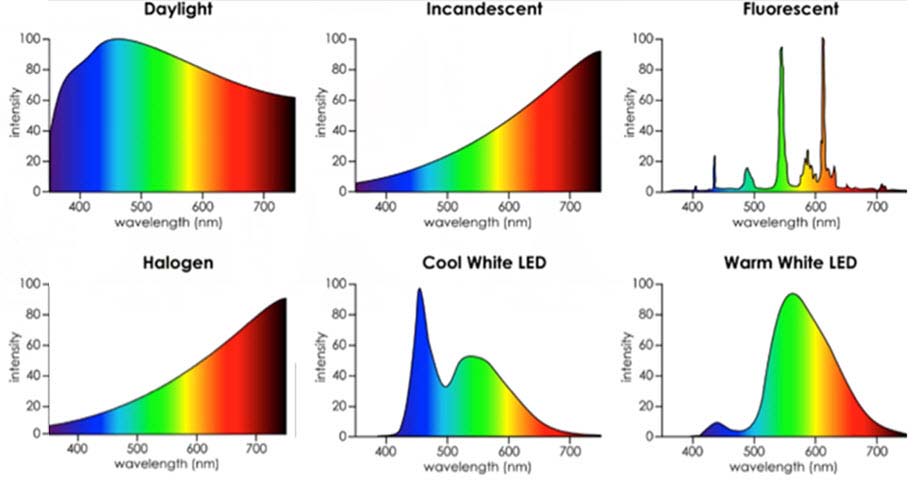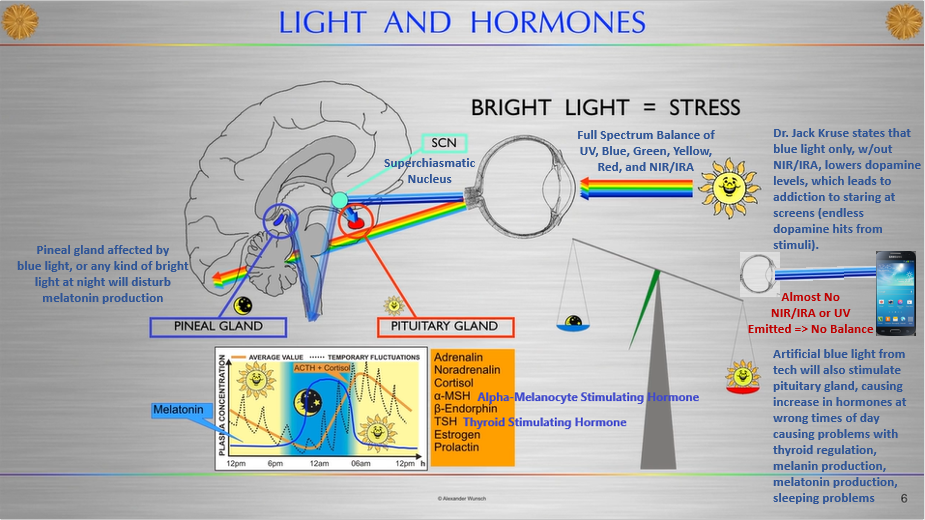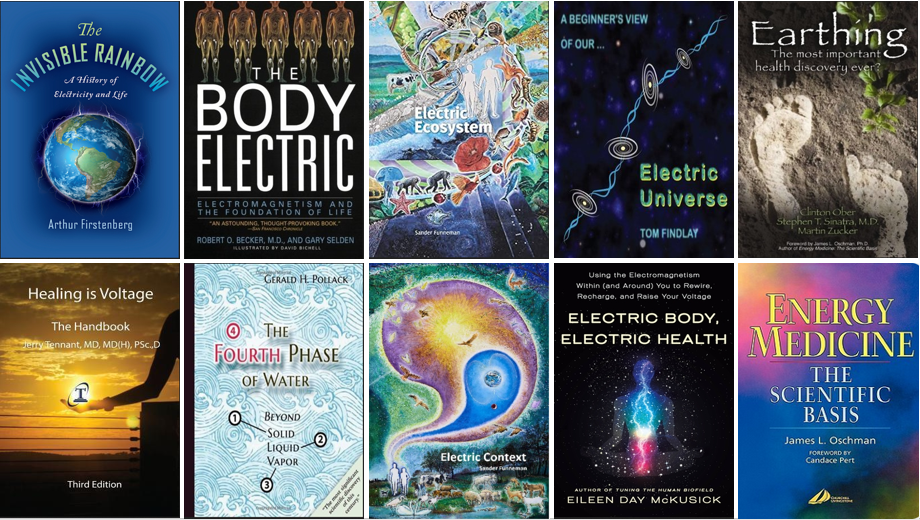In 2022, the USA banned the manufacture of incandescent bulbs and I had intuitively felt this was a bad move despite the claims by many of extreme energy savings from the switch to light emitting diodes (LEDs). My first thought when walking down a street with new LED streetlights a couple of years ago was that the light was overly bright and “harsh.” I also remembered seeing rumblings on the internet over the years that light from LEDs was maybe not so good for you but it had yet to really click for me until I stumbled onto Dr. Jack Kruse’s conversation with the DemystifySci team a couple of weeks ago. I’ve been researching the industrial EMF issue (Wi-Fi, 4G, 5G, etc.) for almost 4 years now and I’m surprised I hadn’t really looked into the blue light issue more deeply. Figures 1 depicts the cold white LED spectrum, the natural sunlight spectrum, and other spectrums for reference for the rest of this post. The spectrum emitted from LCD screens of technologic devices is similar to that of LEDs. If there are health problems associated with this artificial blue light spectrum then the energy savings argument falls apart as healthcare is one of the most energy intensive areas of the economy.

In the DemystifySci podcast at timestamp 1:08:00, Dr. Jack Kruse makes a point that the neuropeptide pro-opiomelanocortin (POMC) is normally used by the body in natural sunlight to generate a number of biologically active peptides including adrenocorticotropic hormone (ACTH), melanocyte-stimulating hormone (MSH) and B-endorphin (an opiate, sunlight makes us feel good!). However, he states that the spike in blue light intensity (~400-480 nm) in the emission spectrum from LEDs and tech devices, which is not balanced with UV or infrared light like it is in sunlight, causes neuropeptide cleavage in POMC to occur in such a way that lowers people’s dopamine levels and they then become addicted to screen scrolling/web surfing (endless dopamine hits in a subconscious attempt to get back to normal).
Photobiology
Dr. Alexander Wunsch is a photobiologist from Germany who has given some compelling presentations (available online) about natural light (sunlight, moonlight), circadian rhythms in organisms and the effects of artificial light (LEDs, incandescent bulbs, etc.) on our health. Incandescent bulbs are generally better for our health than fluorescent bulbs or LEDs. His research findings and discussions seem to solidly back up Dr. Jack Kruse’s claims. Dr. Jack Kruse and Dr. Alexander Wunsch seem to be the two people that have the best handle on this particular subject, as far as I can tell from my recent research. Not surprisingly, the LED/tech industry and governments say there is not much of a problem with this blue light. Though it is nice (and kind of telling) that in the past 5 years or so many devices like smartphones and laptops now come with a “Night Light” or “Dark” mode that removes much of the blue light spike from their emission spectrum.
Below is Figure 2, I modified one of Alexander Wunsch’s slides from one of his presentations and added more info. Basically, the figure shows that blue light from devices (that are also emitting RF and microwave radiation but not UV or infrared light) and LEDs disrupt circadian rhythms by stimulating the pituitary and pineal glands at the wrong times of the day. The other big interrelated point is that almost the entire near infrared/infrared-A (NIR/IRA) spectrum is missing from these devices and LEDs. This infrared spectrum is now well known to have several health benefits including increasing the size and charge of exclusion zone (EZ) water in the body and improved circulation in capillaries. All in all, it should be noted that blue light is actually beneficial when it occurs in sunlight in the late morning and mid-day as it is emitted along with the rest of the natural sunlight spectrum but when it isn’t, it has definite harmful effects on health.

Esoteric Problems with Artificial Light
One of the disturbing thoughts that crossed my mind while doing this research is that what if LEDs were deliberately designed to have a spike in blue light intensity at around 440-460nm to artificially stimulate the pituitary gland of workers, thereby making them more productive, but not telling workers about the harmful long-term effects? The work, work, work, money, money, money, buy, buy, buy, consumerist culture. The system offers us free or cheap coffee, overhead lights with the blue light spike in their spectrum, and blue light backlit screens, all for short-term stimulation, but we pay for it later with myriad health problems (e.g. disrupted sleep, adrenal burnout, metabolism/weight gain issues, etc.). It also could just be that most experts in our society work in very isolated silos and do not communicate much (e.g. LED engineers do not go to biochemistry or photobiology conferences) and that maybe the cheapest material available for creating LEDs causes them to emit that blue light spike.
To back up the above discussion, below is Figure 3, a snapshot of the sections of the podcast between Dr. Alexander Wunsch and Luke Storey where they discuss why industrialists wanted certain types of lighting in their factories and offices.

Another disturbing finding I found when going down this rabbit hole was that in most organisms there is a class of enzymes in an enzymatic pathway called the cytochrome p450 pathway. The “p450” is a reference to the fact that the enzymes in this pathway have peak light absorption at about 450nm, the exact same peak in the blue light spectrum of most LEDs and screens of tech devices. Couple this with the fact that Wi-Fi sends out a signal at a frequency of 2.45GHz, a frequency which strongly affects water molecules and, again, this may make one think of possible intentional manipulation of human biology by the techno-industrial system. Building Biology advocate Roman Shapoval gives a good overview of the p450 problem and other similar esoteric problems with blue light in this substack article.
Conclusion
Of course, it seems that some engineers are actually making strides in developing LEDs and technologic devices that do not emit as much blue light as there previous generations did. But even with that, this post does go to show you, that being outside more and not indoors surrounded by Wi-Fi and blue light all the time is a good idea. The information in this post may also be pertinent to the theories of why there is so much more respiratory illness in winter than in summer in many places around the world, people are just inside so much more in winter than in summer, bathed in Wi-Fi frequencies and blue light vs. the full spectrum from the sun.
In conclusion, light (electromagnetic) pollution is a very real problem, but is not taken seriously by mainstream society as much as chemical pollution in soil, air and water is. Light pollution is mostly considered only to be something that “blocks out the stars,” but it is much more than that as explained briefly in this post. Robert O. Becker, author of The Body Electric, stated that he thought exposure to electromagnetic pollution was even more of a concern than exposure to chemicals (e.g. PCBs, chlorinated solvents, gasoline vapors, etc.). If you have some time this winter be sure to check out Dr. Becker’s book and these other books in the image below if you are interested in a new scientific paradigm that recognizes electromagnetic energy as the foundational fabric of the cosmos.

